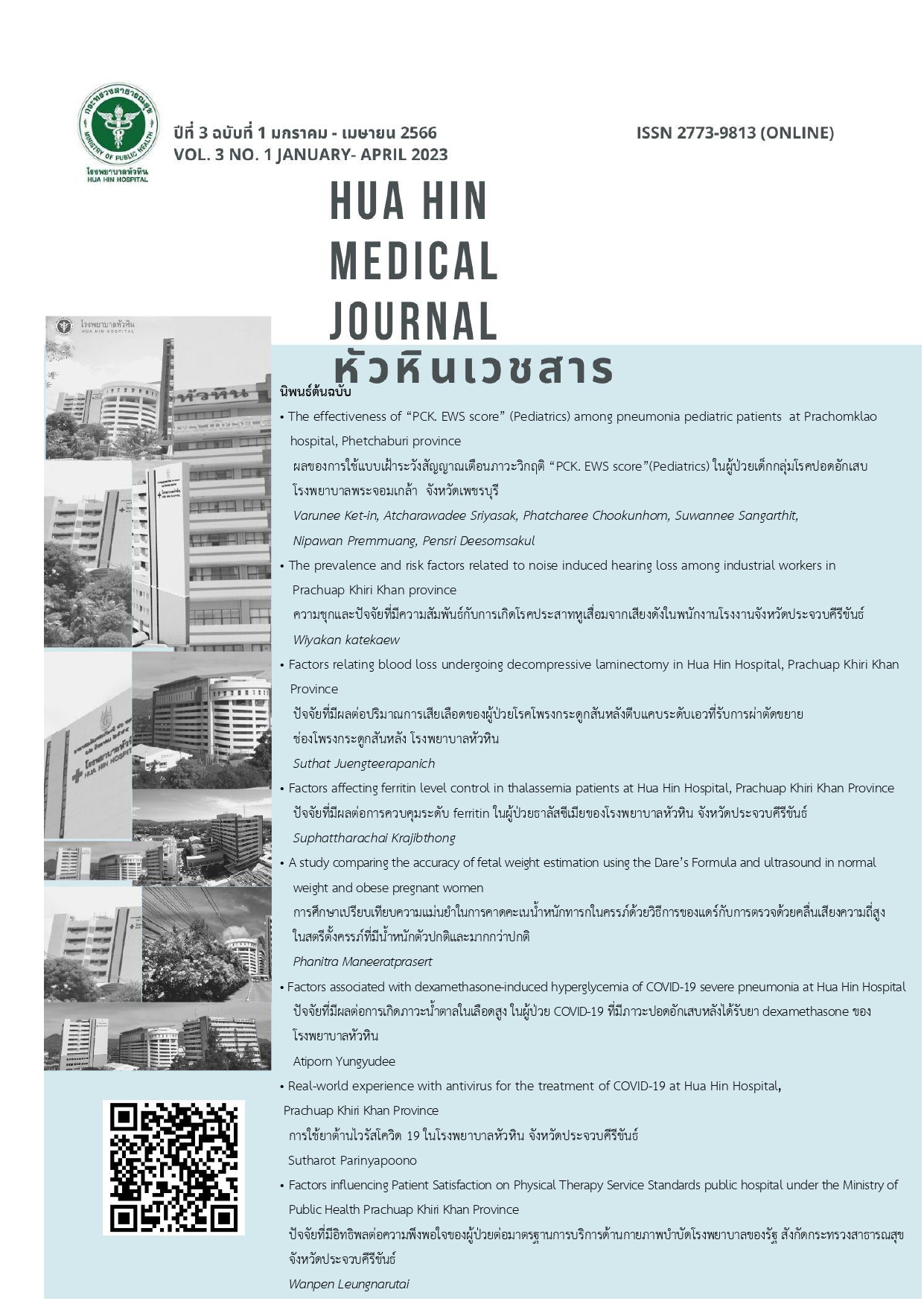The prevalence and risk factors related to noise induced hearing loss among industrial workers in Prachuap Khiri Khan province
Keywords:
noise induced hearing loss, audiometric testingAbstract
Background: Noise-induced hearing loss (NIHL) is the second-most common sensorineural hearing loss, and that can be prevented. Although NIHL does not result in death, it can cause disability and need for hearing aids. In Prachuap Khiri Khan province, several food processing industries generate excessive noise and require hearing screening for industrial workers.
Objectives: To study the prevalence and risk factors associated with NIHL, including gender, age, smoking, alcohol intake, underlying diseases, regular medications, ear symptoms, past medical history, year(s) of working experience, time exposed to loud noise per day, behavior of using noise protective devices while working and knowledge of NIHL.
Methods: This study was a cross-sectional study. The sample consisted of 346 workers from 3 factories in Prachuap Khiri Khan province who were exposed to noise exceeding 85 decibels. All workers were subjected to audiometric testing and completed questionnaires on general information and knowledge of hearing loss. Data were collected from September 2022 to October 2022 and analyzed using descriptive statistics (frequency, percentage, mean, and standard deviation) and inferential statistics (the chi-square test) at a significance level of 0.05.
Results: The prevalence of NIHL was 8.4%, which could be divided into subgroups of early NIHL (4.9%) and NIHL (3.5%). The risk factors related to NIHL with statistical significance included past medical history, ear symptoms, time exposure to loud noise per day, regular medications, behavior of using noise protective devices and knowledge of hearing loss. Meanwhile, other factors such as gender, age, underlying disease, smoking, alcohol intake and year(s) of working experience were not correlated with NIHL.
Conclusion: The surveillance of NIHL in employees exposed to loud noise exceeds the standard through annual hearing screening, which will help identify employees with NIHL or early NIHL. These employees should be educated on NIHL and provided with adequate hearing protection equipment.
References
Nelson DI, Nelson RY, Concha-Barrientos M, Fingerhut M. The global burden of occupational noise-induced hearing loss. Am J Ind Med 2005;48:446-58.
World Health Organization. Hearing loss due to recreational exposure to loud sounds: A review [Internet]. [Cited 2022 Mar 23]. Available from: https://apps.who.int/iris/bitstream/ha ndle/10665/154589/9789241508513_ eng.pdf?sequence=1&isAllowed=y
Occupational Health and Safety Administration, United states department of labor. Occupational Noise Exposure: overview. [Internet]. [Cited 2022 Mar 23]. Available from: https://www.osha.gov/noise
U.S. department of health and human services, Public Health Service, Centers for Disease Control and Prevention, National Institute for Occupational Safety and Health. Criteria for a commended standard Occupational noise exposure revised criteria 1998. [Internet]. [Cited 2022 Mar 23]. Available from: https://www.cdc.gov/niosh/docs/98- 126/pdfs/98-126.pdf
Occupational Health and Safety Administration, United states department of labor. Hearing Conservation. [Internet]. [Cited 2022 Mar 23]. Available from: https://www.osha.gov/sites/default/fi les/publications/osha3074.pdf
รัตนาภรณ์ เพ็ชรประพันธ์, วันดี ไข่มุกด์, ฐิติวร ชูสง. การประเมินระดับเสียงและสมรรถภาพการ ได้ยินของพนักงานโรงงานโม่หินแห่งหนึ่งใน จังหวัดนครศรีธรรมราช. วารสารความ ปลอดภัยและสุขภาพ 2558;8(27):13-23.
ศูนย์พัฒนาวิชาการอาชีวอนามัยและสิ่งแวดล้อม จังหวัดสมุทรปราการ กรมควบคุมโรค กระทรวงสาธารณสุข. แนวทางการเฝ้าระวัง ป้องกันภาวะสูญเสียการได้ยินจากเสียงดัง จากการประกอบอาชีพ. [อินเทอร์เน็ต]. [วันที่อ้างถึง 23 มีนาคม 2565]. ที่มา: https://ddc.moph.go.th/oehdc/journ al_detail.php?publish=10308
สำนักโรคจากการประกอบอาชีพและสิ่งแวดล้อม กรมควบคุมโรค กระทรวงสาธารณสุข. แนว ทางการตรวจคัดกรองสมรรถภาพการได้ยิน และการแปลผล (ฉบับปรับปรุง ปี2560). [อินเทอร์เน็ต]. [วันที่อ้างถึง 23 มีนาคม 2565]. ที่มา: http://envocc.ddc.moph.go.th/uploa ds/samutprakarn/1hearing_chep4_ba seline_29May%2018.pdf
มูลนิธิสัมมาอาชีวะ. แนวทางการตรวจและแปล ผลสมรรถภาพการได้ยินในงานอาชีวอนามัย พ.ศ. 2561. [อินเทอร์เน็ต]. [วันที่อ้างถึง 23 มีนาคม 2565]. ที่มา: http://safetyhubs.com/wp- content/uploads/2018/11/book_audi ometry.pdf
เทิดศักดิ์ ผลจันทร์, สุเมธ พีรวุฒิ, สาธิต ชยาภัม, พิชญา ตันติเศรณี. ความชุกของภาวะ ประสาทรับเสียงเสื่อมจากเสียงและปัจจัยที่ เกี่ยวข้องในพนักงานงานโภชนาการ งาน วิศวกรรมซ่อมบำรุง และงานจ่ายผ้ากลาง คณะแพทยศาสตร์ มหาวิทยาลัยสงขลานครินทร์. สงขลา นครินทร์เวชสาร 2547;22(1):27-36.
พัฒนาพร กล่อมสุนทร, ทุวัน สิมมะลิ, บารเมษฐ์ ภิราล้ำ. ความชุกและปัจจัยที่มี ความสัมพันธ์กับการสูญเสียสมรรถภาพการ ได้ยินจากการสัมผัสเสียงดังในพนักงาน โรงงานน้ำตาลสหเรือง จังหวัดมุกดาหาร. วารสารสำนักงานป้องกันควบคุมโรคที่ 7 2556;11(4):40-51.
Kou-Huang Chen1, Shih-Bin Su, Kow- Tong Chen. An overview of occupational noise-induced hearing loss among workers: epidemiology, pathogenesis, and preventive measures. Environmental Health and Preventive Medicine 2020;25:65.
รุ่งนภา สิงห์สถิตย์, รัชดาพร ฐานมั่น. ความสัมพันธ์ของความรู้และทัศนคติต่อ พฤติกรรมการสร้างเสริมสุขภาพของ อาสาสมัครสาธารณสุขประจำหมู่บ้าน อำเภอสวนผึ้ง จังหวัดราชบุรี. [อินเทอร์เน็ต]. [วันที่อ้างถึง 23 มีนาคม 2565]. ที่มา: http://rms.mcru.ac.th/uploads/162015.pdf
ธีระศิษฏ์ เฉินบำรุง, วิทยา พิเชฐวีรชัย, ศิรินทิพย์ ชาญด้วยวิทย์, วนิดา อินชิต,วันทนีย์ หวาน ระรื่น. การเกิดร่องและขนาดของร่องที่พบ ได้จากตรวจสมรรถภาพการได้ยินประจำปี ของพนักงานสถานประกอบการ 9 แห่งใน จังหวัดระยอง. วารสารสาธารณสุขศาสตร์ 2561;48(1):33-43.
Paul W. Flint, Bruce H. Haughey, Valerie J. Lund, John K. Niparko, Mark A. Richardson, K. Thomas Robbins. et al, editor. Cummings otolaryngology head & neck surgery. 5th ed. Philadelphia: Elsevier; 2010. p. 2116-52.
นันท์มนัส บุญโล่ง, ศราวุธ ดำอุดม, กมลพรรณ โลหกุล, รุ่งกานต์ เพชรล้วน. ความชุกของ การสูญเสียสมรรถภาพการได้ยินและ ความสัมพันธ์ระหว่าง ปัจจัยคัดสรรกับการ สูญเสียสมรรถภาพการได้ยินในการ ปฏิบัติ งาน.วารสารวิชาการแพทย์ เขต 11 2556;27:327-336.
Benjamin S Bloom. 1986. ‘Learning for mastery’. Evaluation comment. Center for the study of instruction program. University of California at Los Angeles. Vol 2:47-62.
Green lW, Kreuter MW. Health program planning: An educational and ecological approach. 4th ed. New York: Emily Barrosse; 2005.
Downloads
Published
How to Cite
Issue
Section
License
Copyright (c) 2023 Hua-Hin Hospital

This work is licensed under a Creative Commons Attribution-NonCommercial-NoDerivatives 4.0 International License.
บทความที่ได้รับการตีพิมพ์ในวารสารหัวหินเวชสาร เป็นลิขสิทธิ์ของโรงพยาบาลหัวหิน
บทความที่ลงพิมพ์ใน วารสารหัวหินเวชสาร ถือว่าเป็นความเห็นส่วนตัวของผู้เขียนคณะบรรณาธิการไม่จำเป็นต้องเห็นด้วย ผู้เขียนต้องรับผิดชอบต่อบทความของตนเอง







